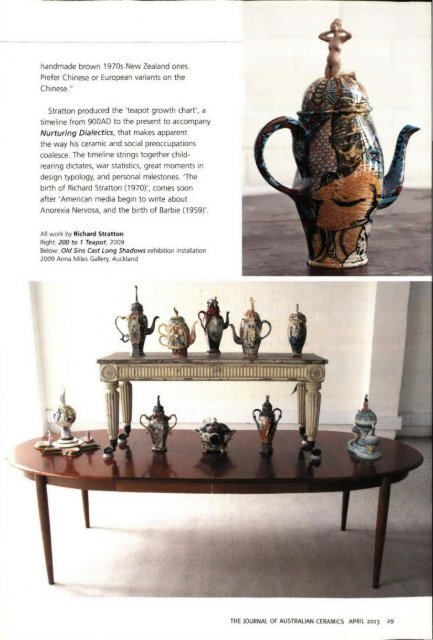The Journal of Australian Ceramics Vol 52 No 1 April 2013
Create successful ePaper yourself
Turn your PDF publications into a flip-book with our unique Google optimized e-Paper software.
Focus : New Zealand <strong>Ceramics</strong><br />
Raewyn Atkinson Wasters /11, <strong>2013</strong><br />
work in progress, found ceramic and laser decals<br />
various dimensions; photo: artist<br />
solving a complex puzzle. Atkinson suggests that "shards are enduring; they are what we use as a tool<br />
to construct our culture and history - we need them in order to make our understanding whole" .2<br />
While considering what to do with these countless pieces <strong>of</strong> broken pottery, Atkinson was drawn to<br />
the accidental outcomes <strong>of</strong> the ceramic process. Of particular interest was an example <strong>of</strong> a Delft 'waster'<br />
- stacks <strong>of</strong> individual ceramic pieces that have become fused during the firing process. <strong>The</strong>se (<strong>of</strong>ten<br />
beautiful) malfunctions <strong>of</strong> pottery production share elements <strong>of</strong> the intentions <strong>of</strong> Atkinson's Deep Time<br />
#26 - a tangible instance <strong>of</strong> the potential for failure and also representative <strong>of</strong> the physical evidence <strong>of</strong><br />
history. Using the shards from Tepco Beach as a starting point, Atkinson has begun incorporating images<br />
and impressions collected while at Berkeley into her work. Obvious references to over-consumption,<br />
such as shopping trolleys used by the homeless or stacked w ith black plastic bags ready for the<br />
recycling station, become provocative statements in place <strong>of</strong> the decorative motifs commonly found on<br />
dinnerware. Th is is what Atkinson refers to as a "revisionist approach" 3 - her attempt at reconstructing<br />
history through a personal lens.<br />
Th is predisposition towards combining historical references w ith the artist's own impressions and<br />
experiences is what allows Atkinson's practice to have currency. She is intent on commenting not only<br />
on how we have influence over the environment but also how we fictionalise history. For Atkinson, the<br />
shard has become a corporeal agent for a tendency towards what she considers the approximation <strong>of</strong><br />
history. As with my own collecting fetish, shards have become mementos for Atkinson, visual markers <strong>of</strong><br />
the ebb and flow <strong>of</strong> time. <strong>The</strong>y are the substance and the conduits <strong>of</strong> human history in the same way<br />
that core samples are a historical record <strong>of</strong> the environment. Both are reliant on someone making sense<br />
<strong>of</strong> them, tying the pieces together into some semblance <strong>of</strong> truth. As Atkinson reminds us "history can<br />
be a fiction" 4<br />
Karl Chitham is currently the Curator <strong>of</strong> Art at Rotorua Museum<br />
Te Whare Taonga 0 Te Arawa, New Zealand,<br />
1 Felicity M ilburn, 'under Pressure, Raewyn Atkinson's Deep time #26',Art New Zealand, no. 1361$UMME R 2010-2011, pp, 49-53,<br />
2 Raewyn Atkinson, in conversation with the author, January <strong>2013</strong>.<br />
3 ibid.<br />
4 ibid.<br />
THE JOURNAL OF AUSTRALIAN CERAMICS APRIL <strong>2013</strong> 27

















